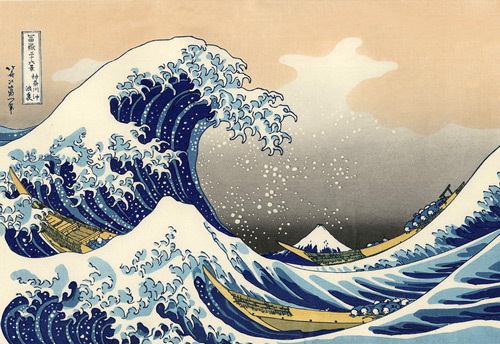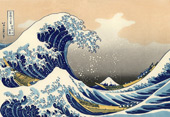The Great Wave off Kanagawa By Katsushika Hokusai
The Great Wave by Katsushika Hokusai, known as Under the Wave off Kanagawa, is the artist's true masterpiece. Created between 1830 and 1832, it’s also one of the most recognizable images of Japanese art.
The print is a “yoko-e,” referring to landscape artworks created in ōban size (roughly 25 centimeters by 37 centimeters).
This small woodcut depicts three boats threatened by an enormous wave. The scene lies just off Sagami Bay (in the Kanagawa Prefecture), with Mount Fuji visible in the background.
Why did Katsushika Hokusai paint The Great Wave?
The Great Wave painting forms part of a more extensive collection, a series entitled Thirty-six Views of Mount Fuji. Within this work, Hokusai offers fascinating glimpses into everyday Japanese life and landscapes.
Hokusai’s exact inspirations for creating this composition remain shrouded in mystery. However, we know he held an enduring artistic fascination (verging on obsession) with the famous mountain.
As the name suggests, every scene features Mount Fuji in some way. It sometimes dominates the pictorial space, offering a mere glimpse into the background.
Hokusai spent his early career (from the age of twelve) working in a bookstore. Later employed as an engraver and an apprentice to the legendary Katsukawa Shunshō, Hokusai had immense knowledge of artistic techniques and practices.
He only produced Thirty-six Views of Mount Fuji at 70, although he created many of The Great Wave paintings throughout his long career. Hokusai's paintings, View of Honmoku off Kanagawa (c.1803) and Cargo Boat Passing through Waves (c.1805), present similar views of small ships dwarfed by towering waters.
What does The Great Wave by Hokusai symbolize?
Fiercely debated amongst art historians, The Great Wave of Kanagawa is a topic of intense interest. Yet, in this woodcut, Japan’s grandest mountain appears as a small, seemingly insignificant detail amidst a swirling wave.
The wave appears as an enormous, shifting monster, perhaps symbolizing the power of nature. It almost crushes the comparatively tiny boats drawn into its undulating motion. As “oshiokuri-bune,” these fast boats primarily transported live fish to Japan’s thriving coastal markets.
Not only does Mount Fuji provide perspective to the piece, but it also represents stillness and solidity. In Japanese culture, Mount Fuji is a sacred object of worship and an emblem of national identity and beauty. It also links to ideas of immortality and eternity within Buddhist and Daoist traditions.
Indeed, a popular interpretation of the mountain’s name suggests “Fu-Shi,” which translates directly as “not death.” Instead, Katsushika Hokusai's paintings could represent his ambitions for artistic immortality.
Contrasting this, however, is the unceasing unpredictability of the ocean representing life and death, white and dark, the essential opposites that fascinate all great artists.
The wave’s claw-like white foam contrasts with the Prussian Blue and Indigo pigments forming the depths of Hokusai’s ocean. Prussian Blue was a relatively new material at the time, of which Hokusai took full advantage.
Why did Hokusai create Mount Fuji artwork?
The Great Wave forms part of a more extensive collection, a series entitled Thirty-six Views of Mount Fuji. Within this work, Hokusai offers fascinating glimpses into everyday Japanese life and landscapes.
Hokusai’s exact inspirations for creating this composition remain shrouded in mystery. However, we know he held an enduring artistic fascination (verging on obsession) with the famous mountain.
As the name suggests, every scene features Mount Fuji in some way. It sometimes dominates the pictorial space, offering a mere glimpse into the background.
Hokusai spent his early career (from the age of twelve) working in a bookstore. Later employed as an engraver and an apprentice to the legendary Katsukawa Shunshō, Hokusai had immense knowledge of artistic techniques and practices.
He produced Thirty-six Views of Mount Fuji at age 70, although he created many Great Wave paintings throughout his long career. For example, Hokusai paintings View of Honmoku off Kanagawa (c1803) and Cargo Boat Passing through Waves (c1805) present similar views of small ships dwarfed by towering waters.
Where is Hokusai's original artwork?
Katsushika Hokusai’s The Great Wave is held (alongside an extensive collection of other Hokusai and Japanese art) by the Metropolitan Museum in New York. The series was incredibly popular, and around 5,000 copies were likely produced.
It’s thus incredibly difficult to pinpoint one single original Katsushika Hokusai art. However, original impressions are at the Art Institute of Chicago, Claude Monet’s Giverny home, the Brussels Art and History Museum, and the Museum für Kunst und Gewerbe in Hamburg.
Reflecting the continued importance of the work, the museum purchased the print for £130,000 back in 2008
Hokusai art forms part of our standard catalog of famous art reproductions.
, known as Under the Wave off Kanagawa, is the artist's true masterpiece. Created between 1830 and 1832, it’s also one of the most recognizable images of Japanese art.
The print is a “yoko-e,” referring to landscape artworks created in ōban size (roughly 25 centimeters by 37 centimeters).
This small woodcut depicts three boats threatened by an enormous wave. The scene lies just off Sagami Bay (in the Kanagawa Prefecture), with Mount Fuji visible in the background.
Why did Katsushika Hokusai paint The Great Wave?
The Great Wave painting forms part of a more extensive collection, a series entitled Thirty-six Views of Mount Fuji. Within this work, Hokusai offers fascinating glimpses into everyday Japanese life and landscapes.
Hokusai’s exact inspirations for creating this composition remain shrouded in mystery. However, we know he held an enduring artistic fascination (verging on obsession) with the famous mountain.
As the name suggests, every scene features Mount Fuji in some way. It sometimes dominates the pictorial space, offering a mere glimpse into the background.
Hokusai spent his early career (from the age of twelve) working in a bookstore. Later employed as an engraver and an apprentice to the legendary Katsukawa Shunshō, Hokusai had immense knowledge of artistic techniques and practices.
He only produced Thirty-six Views of Mount Fuji at 70, although he created many of The Great Wave paintings throughout his long career. Hokusai's paintings, View of Honmoku off Kanagawa (c.1803) and Cargo Boat Passing through Waves (c.1805), present similar views of small ships dwarfed by towering waters.
What does The Great Wave by Hokusai symbolize?
Fiercely debated amongst art historians, The Great Wave of Kanagawa is a topic of intense interest. Yet, in this woodcut, Japan’s grandest mountain appears as a small, seemingly insignificant detail amidst a swirling wave.
The wave appears as an enormous, shifting monster, perhaps symbolizing the power of nature. It almost crushes the comparatively tiny boats drawn into its undulating motion. As “oshiokuri-bune,” these fast boats primarily transported live fish to Japan’s thriving coastal markets.
Not only does Mount Fuji provide perspective to the piece, but it also represents stillness and solidity. In Japanese culture, Mount Fuji is a sacred object of worship and an emblem of national identity and beauty. It also links to ideas of immortality and eternity within Buddhist and Daoist traditions.
Indeed, a popular interpretation of the mountain’s name suggests “Fu-Shi,” which translates directly as “not death.” Instead, Katsushika Hokusai's paintings could represent his ambitions for artistic immortality.
Contrasting this, however, is the unceasing unpredictability of the ocean representing life and death, white and dark, the essential opposites that fascinate all great artists.
The wave’s claw-like white foam contrasts with the Prussian Blue and Indigo pigments forming the depths of Hokusai’s ocean. Prussian Blue was a relatively new material at the time, of which Hokusai took full advantage.
Why did Hokusai create Mount Fuji artwork?
The Great Wave forms part of a more extensive collection, a series entitled Thirty-six Views of Mount Fuji. Within this work, Hokusai offers fascinating glimpses into everyday Japanese life and landscapes.
Hokusai’s exact inspirations for creating this composition remain shrouded in mystery. However, we know he held an enduring artistic fascination (verging on obsession) with the famous mountain.
As the name suggests, every scene features Mount Fuji in some way. It sometimes dominates the pictorial space, offering a mere glimpse into the background.
Hokusai spent his early career (from the age of twelve) working in a bookstore. Later employed as an engraver and an apprentice to the legendary Katsukawa Shunshō, Hokusai had immense knowledge of artistic techniques and practices.
He produced Thirty-six Views of Mount Fuji at age 70, although he created many Great Wave paintings throughout his long career. For example, Hokusai paintings View of Honmoku off Kanagawa (c1803) and Cargo Boat Passing through Waves (c1805) present similar views of small ships dwarfed by towering waters.
Where is Hokusai's original artwork?
Katsushika Hokusai’s The Great Wave is held (alongside an extensive collection of other Hokusai and Japanese art) by the Metropolitan Museum in New York. The series was incredibly popular, and around 5,000 copies were likely produced.
It’s thus incredibly difficult to pinpoint one single original Katsushika Hokusai art. However, original impressions are at the Art Institute of Chicago, Claude Monet’s Giverny home, the Brussels Art and History Museum, and the Museum für Kunst und Gewerbe in Hamburg.
Reflecting the continued importance of the work, the museum purchased the print for £130,000 back in 2008
Hokusai art forms part of our standard catalog of famous art reproductions.
We offer a 100% money back guarantee or replacement service. If for any reason you are dissatisfied with your painting please contact us within 7 days of receipt, advising the reason you are unhappy and we will provide you with all the information you need for its return or replacement.
We ship free to anywhere in the world via FedEx or DHL expedited service with online tracking.
Your painting will be shipped rolled in strong plastic tubing, ready for stretching and/or framing locally. This is the conventional method of transporting hand-painted oil on canvas. Learn more about how your painting is shipped.
We are able to offer a framing service intercontinental U.S. Please contact us if you would like a quotation. Alternatively, should you prefer, we can recommend a framer in your area.
Notes About Your Painting
Please note that replica oil paintings are finished with an additional 10cm (4") of extra canvas on all sides, allowing ample surplus canvas for stretching and framing.
Recently Viewed:
Cannot Find What You Are Looking For?
Reproduction Gallery Information
Customer Service
(Send Us A Message)
Tel: (503) 937 2010
Fax: (503) 937 2011







